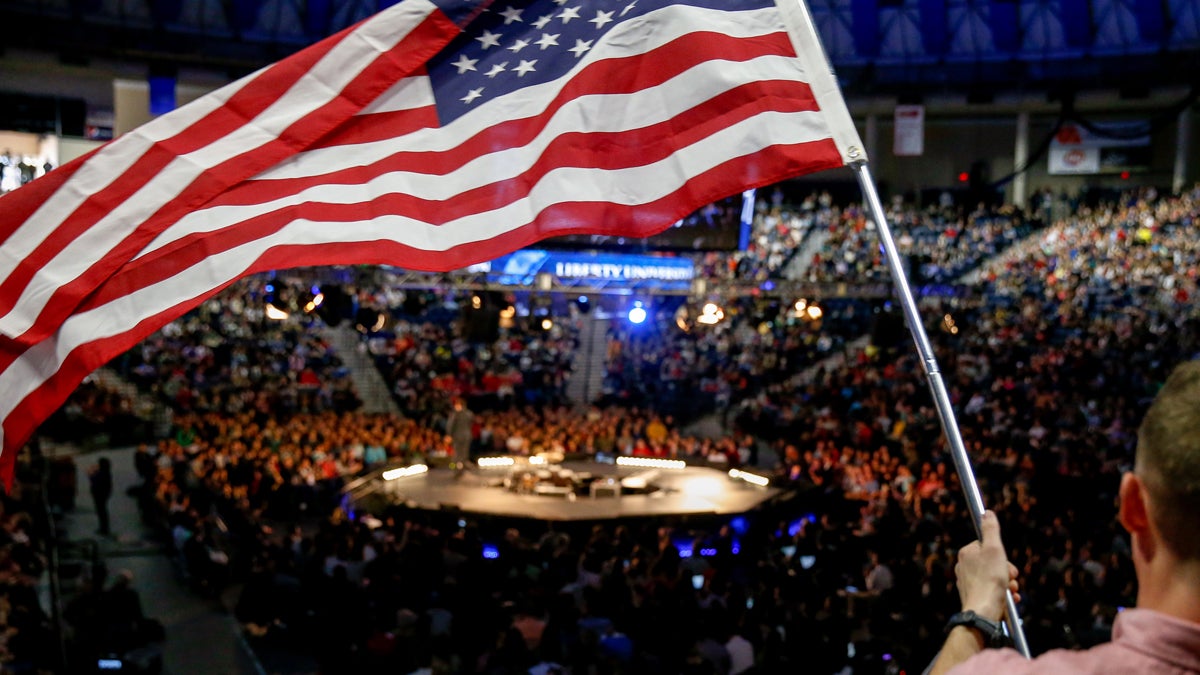The GOP’s high demographic hurdles

A man in the audience waves an American flag at Liberty University (Andrew Harnik/AP Photo)
Forget the joke candidacies of Rand Paul and Ted Cruz. Forget Scott Walker and his constant attempts to link himself to Reagan. Forget Jeb Bush and his deep-pocket donors. Forget Marco Rubio and his imminent announcement. Think not about Mike Huckabee and Bobby Jindal and Ben Carson and Chris Christie and Mike Pence. Forget them all – at least for the moment.
Instead, let’s crunch some numbers; that way, you’ll quickly see how tough it could be for any of those wannabees to win in 2016.
The nonpartisan Pew Center has now released an exhaustive survey of the American electorate – based on 25,000 interviews nationwide, roughly 20 times the size of the basic snapshot sample – and here’s the upshot:
The GOP is still the party of white guys (especially southerners and oldsters). Its sporadic attempts to diversify have come to naught. And there is virtually no way that a party of white guys can win a presidential election, not in this century.
The numbers tell the tale from every demographic angle. Take gender, for instance. On election day in 2012, women comprised 53 percent of the voting electorate. If women continue to outvote men in 2016 – which they will, if the recent election pattern holds, and especially if Hillary Clinton is on the ballot – Republicans risk a gender chasm. Because according to Pew’s party affiliation stats, women currently favor the Democrats by a whopping 16 percentage points – 52 to 36.
By the way, Republicans won’t narrow that chasm in time for 2016 if Rand Paul keeps beating up on female interviewers. But I digress.
On the age front, the GOP remains strongest among seniors – and that’s an asset, since seniors are habitual voters. But seniors favor the GOP over the Democrats by only four percentage points, 47 to 43. By contrast, the rising Millennials (aged 18 to early 30s) remain overwhelmingly Democratic – by 16 points, 51 to 35. Those voters didn’t bother to show up in the ’10 and ’14 midterms, but their participation surged in the last two presidential races, and, as evidenced by the new affiliation stats, their heavy Democratic tilt didn’t die with Barack Obama’s final campaign.
By the way, Millennials are the most gay-friendly age cohort in the electorate. Republicans don’t have a prayer of narrowing their deficit among Millennials if they keep insisting that bigoted business owners have the right to refuse service in the name of God. But I digress.
Race is the biggest deal-breaker. The GOP remains strong among white people – 49 percent of whom identify as Republicans, a nine-point lead over Democrats. The problem, however, is that whites are a steadily declining share of the presidential electorate. According to stats from the U.S. Census, whites were 82.5 percent of the voters back in 1996; in 2012, the white share was only 73.7 percent. That’s a nearly nine-point drop.
During that same 16-year span, the black share of the voting electorate jumped three percentage points; the Hispanic share jumped four points. Hispanics wiped out Mitt “Self-Deportation” Romney in 2012, costing him at least four states. (The Asian-American share of the electorate has also risen, and has trended heavily Democratic since 1992.)
Hence the GOP’s demographic dilemma. Its reality-based strategists know what needs to be done if the party is going to compete in ’16. At a press breakfast 10 days ago, party pollster Whit Ayres flatly said that if the next Republican nominee can capture 59 percent of the white vote (matching Romney’s share), he will also need 30 percent of the non-white vote (nearly double Romney’s share). Ayres said the latter goal can be met if the candidate wins “almost a majority” of Hispanics.
Good luck with all that. Presumably, he’s figuring that either Marco Rubio (coincidentally, his client) or Jeb Bush (the self-described Hispanic) can draw a near-majority of Hispanics, but history says that’s a long shot. The GOP’s high-water mark was George W.’s 44 percent in 2004. And on the Democratic side, Hillary Clinton demonstrated during the ’08 primaries that she’s strong among Hispanics. Plus, she’ll arguably do better among whites than Obama did, putting even more pressure on the GOP to double their non-white share.
So whatever the candidates say and do between now and November ’16, please be advised that, in all likelihood, demography is destiny.
——-
OK, back to Rand Paul. My favorite flip-flop came in February when the aspiring commander-in-chief got into a spat with a female CNBC interviewer (“Shhh, calm down a bit here, Kelly”) on the issue of mandatory child vaccinations. He said he was against them, because freedom (Sarcastically: “I guess being for freedom would be really unusual”), and that because of vaccines, he knew many “walking, talking children who wound up with profound mental disorders” (he provided no actual examples).
Then, one day later, having realized that he sounded like a fringe loon, he arranged to be photographed getting vaccinated and said that all kids should be vaccinated. The money quote: “It just annoys me that I’m being characterized as someone who’s against vaccines.”
Follow me on Twitter, @dickpolman1, and on Facebook.
WHYY is your source for fact-based, in-depth journalism and information. As a nonprofit organization, we rely on financial support from readers like you. Please give today.

